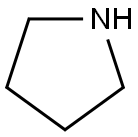Tetrahydropyran , 99% , 142-68-7
Synonym(s):
Pentamethylene oxide
CAS NO.:142-68-7
Empirical Formula: C5H10O
Molecular Weight: 86.13
MDL number: MFCD00006585
EINECS: 205-552-8
PRODUCT Properties
| Melting point: | -45 °C (lit.) |
| Boiling point: | 88 °C (lit.) |
| Density | 0.881 g/mL at 25 °C (lit.) |
| vapor density | 3 (vs air) |
| refractive index | n |
| Flash point: | 4 °F |
| storage temp. | Store below +30°C. |
| solubility | >80.2g/l |
| form | Liquid |
| color | Clear colorless |
| Odor | at 0.10?%?in?dipropylene glycol. pungent sweet ethereal |
| Water Solubility | 80 g/L (25 ºC) |
| Merck | 14,9217 |
| BRN | 102436 |
| Dielectric constant | 7.3(30℃) |
| InChIKey | DHXVGJBLRPWPCS-UHFFFAOYSA-N |
| LogP | 0.950 |
| Surface tension | 27.5mN/m at 293.15K |
| CAS DataBase Reference | 142-68-7(CAS DataBase Reference) |
| NIST Chemistry Reference | 2H-Pyran, tetrahydro-(142-68-7) |
| EPA Substance Registry System | Tetrahydropyran (142-68-7) |
Description and Uses
Tetrahydropyran (THP) is the organic compound consisting of a saturated six-membered ring containing five carbon atoms and one oxygen atom. It is named by reference to pyran, which contains two double bonds, and may be produced from it by adding four hydrogens. Tetrahydropyran can be used as a solvent in various classical organic reactions such as radical reactions, palladium-catalyzed coupling, and Grignard reactions.
It is is an important raw material and intermediate used in Organic Synthesis, Pharmaceuticals, Agrochemicals and dyestuff. They are also used as important solvents, as chemical intermediate and as monomer for ring-opening polymerization.
Safety
| Symbol(GHS) |  GHS02 |
| Signal word | Danger |
| Hazard statements | H225 |
| Precautionary statements | P210-P233-P240-P241-P242-P243 |
| Hazard Codes | F,Xi,Xn |
| Risk Statements | 11-36/37/38-9-19-52/53-22 |
| Safety Statements | 9-16-26-33-36-61 |
| RIDADR | UN 1993 3/PG 2 |
| WGK Germany | 3 |
| TSCA | Yes |
| HazardClass | 3 |
| PackingGroup | II |
| HS Code | 29321100 |
| Hazardous Substances Data | 142-68-7(Hazardous Substances Data) |
| Limited Quantities | 1.0 L (0.3 gallon) (liquid) |
| Excepted Quantities | Max Inner Pack (30g or 30ml) and Max Outer Pack (500g or 500ml) |





